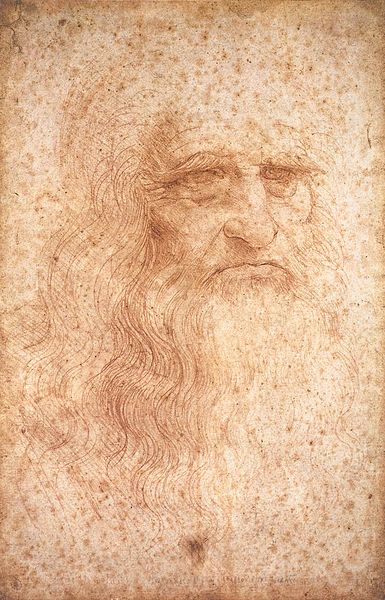
Leonardo da Vinci: Self-portrait. From WikimediaCommons.
Leonardo di ser Piero da Vinci was the archetype of the Renaissance Man: artist, architect, musician, mathematician, engineer, inventor, anatomist, naturalist and geologist. A true polymath. He was born on April 15, 1452 in Vinci, a town in the lower valley of the Arno River. The majority of Leonardo’s scientific observations were in the Leicester Codex, a collection of writings from the 16th Century. Several excerpts from the Codex indicate that Leonard uses many ichnological principles that are still valid today.
The Codex Arundel is similar to the Codex Leicester. It was written between 1480 and 1518. In folio 155r, Leonardo recounted an experience in a cave in the Tuscan countryside: “Unable to resist my eager desire and wanting to see the great multitude of the various and strange shapes made by formative nature, and having wandered some distance among gloomy rocks, I came to the entrance of a great cave, in front of which I stood some time, astonished and unaware of such a thing. Bending my back into an arch I rested my tired hand on my knee and held my right hand over my downcast and contracted eyebrows, often bending first one way and then the other, to see whether I could discover anything inside, and this being forbidden by the deep darkness within, and after having remained there some time, two emo-tions arose in me, fear and desire: fear of the threatening dark cave, desire to see whether there were any wondrous thing within it”.

Reproduction of folios 155v (left corner) and 156r (right corner) of the Codex Arundel. From Collareta et al., 2020.
In the next folio, Leonardo described what appears to have been a fossil whale embedded in the walls of a cave:
“O powerful and once-living instrument of formative nature, your great strength of no avail, you must abandon your tranquil life to obey the law which God and time gave to creative nature. Of no avail are your branching, sturdy dorsal fins with which you pursue your prey, plowing your way, tempestuously tearing open the briny waves with your breast.
Oh, how many a time the terrified shoals of dolphins and big tuna fish were seen to flee before your insensate fury, as you lashed with swift, branching fins and forked tail, creating in the sea, mist and sudden tempest that buffeted and submerged ships…
O Time, swift despoiler of created things, how many kings, how many peoples have you undone? How many changes of state and circumstances have followed since thewondrous form of this fish died here in this winding and cavernous recess? Now unmade by time you lie patiently in this closed place with bones stripped and bare, serving as an armature for the mountain placed over you.”

Tuscan Pliocene fossil mysticetes: (a) ʽPelocetus sp.’ from Le Colombaie, near Volterra (original field sketch by G. Capellini, 1879); (b) Idiocetus guicciardinii from Montopoli (osteoanatomical plate reproduced after Capellini 1905). From Collareta et al., 2020.
In the folio 715r of the Codex Atlanticus, Leonardo described the same animal as ‘setoluto’, i.e. pro-vided with bristles – an observation that strongly evokes the presence of baleen, and as such, a positive identification of the ʽmarine monster’ with a baleen whale. A recent study suggests that Leonardo saw a fossil whale and recognised it as such, but the encounter was most likely along the flank of a hill, where cetacean remains from the Tuscan Pliocene are relatively common. Leonardo also made taphonomic observations on it and inferred that a considerable amount of time must have passed from the death of the whale in the marine realm to allow for its eventual discovery on land.
Leonardo’s legacy is extraordinary and his contributions to historical geology and ichnology are of special relevance. He wrote about the original horizontal arrangement of strata before Nicola Steno’s seminal work. He also provided the first organic observations on concepts such as actualism, taphonomy, and palaeocological inference. But because he never received a formal education in Latin or Mathematics, his writings were ignored by the scholars of the time. Five centuries after his death, Leonardo still surprises us.
References:
Collareta, A., Collareta, M., Berta, A., & Bianucci, G. (2020). On Leonardo and a fossil whale: a reappraisal with implications for the early history of palaeontology, Historical Biology, DOI: 10.1080/08912963.2020.1787403.
Etheridge, Kay. “Leonardo and the Whale.” In Leonardo da Vinci – Nature and Architecture,edited by C. Moffat and S.Taglialagamba, 89-106. Leiden: Brill, 2019.



